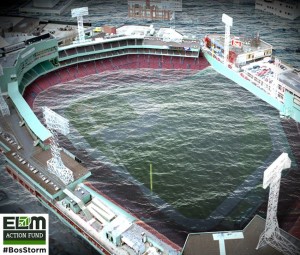We have much more to do and your continued support is needed now more than ever.
Fragile Fenway: Climate Change Puts Historic Red Sox Ballpark at Risk

A Diamond in the Marsh
The 101-year-old Fenway Park is named after The Fens, a saltwater marshland around the Muddy River. Parts of the neighborhood, like much of downtown Boston, were built on filled-in marshy areas. That’s led to several problems:
- Fenway’s playing field is at or even below street level. As recently as 2010, heavy rains flooded the dugouts.
- While recent renovations have helped with drainage – the area under the stands behind home plate no longer smells like a sewer after it rains – short of putting the entire park on stilts, Fenway Park will remain vulnerable.
- The subway station most of the Fenway Faithful use, Kenmore Square, has repeatedly suffered major flooding when the Muddy River has overflowed its banks.
And that’s before we consider that floods are now being made worse by heavier rainfalls and climate change-fueled sea level rise.
The Environmental League of Massachusetts Action Fund, the political wing of the National Wildlife Federation’s state affiliate, recently called attention to the dire situation as superstorm Sandy’s anniversary approached:
“The effects of climate change are real and they are here now,” said ELM Action Fund President George Bachrach. “Boston narrowly dodged a bullet when Sandy hit last year, but eventually a superstorm will hit our city, flooding our hospitals, schools and the MBTA.”
According to the Boston Harbor Association, Sandy’s storm surge could have flooded more than 80 million square feet of the city if the superstorm had hit Boston just five and a half hours earlier at high tide.
Keep in mind Sandy’s center came ashore in New Jersey, hundreds of miles to the south. This video shows the potential damage from a direct hit:
[youtube]http://www.youtube.com/watch?v=kmhXmvvzbwY[/youtube]
See more photos at the Environmental League of Massachusetts Facebook page (and give them a like while you’re there). You can also use this interactive tool designed by StorageFront.com to see what some Boston landmarks would look like with varying amounts of sea level rise and storm surge.
So tonight, I’ll be rooting for the Red Sox from my couch – I’d rather be at Fenway, but I couldn’t find $1,000 in the couch cushions. But I’ll also be rooting for our elected officials to take action on cutting carbon pollution so we can protect Fenway Park for generations to come.
Take Action
Boston will elect a new mayor on Tuesday, November 5. Sign the ELM Action Fund petition asking candidates John Connolly and Marty Walsh to address climate change.






















